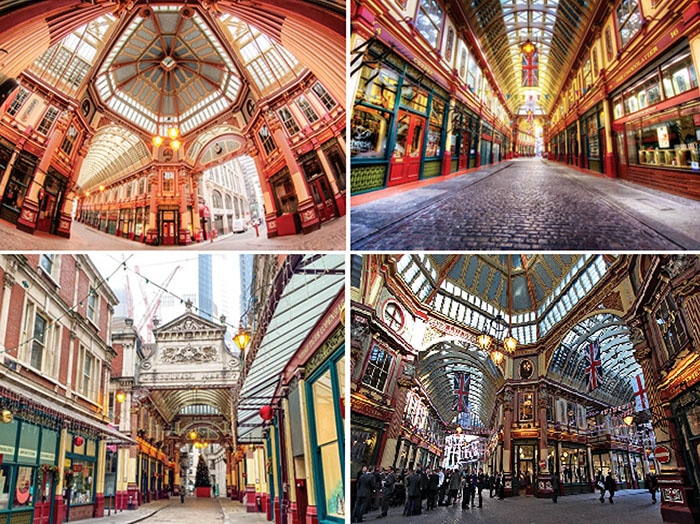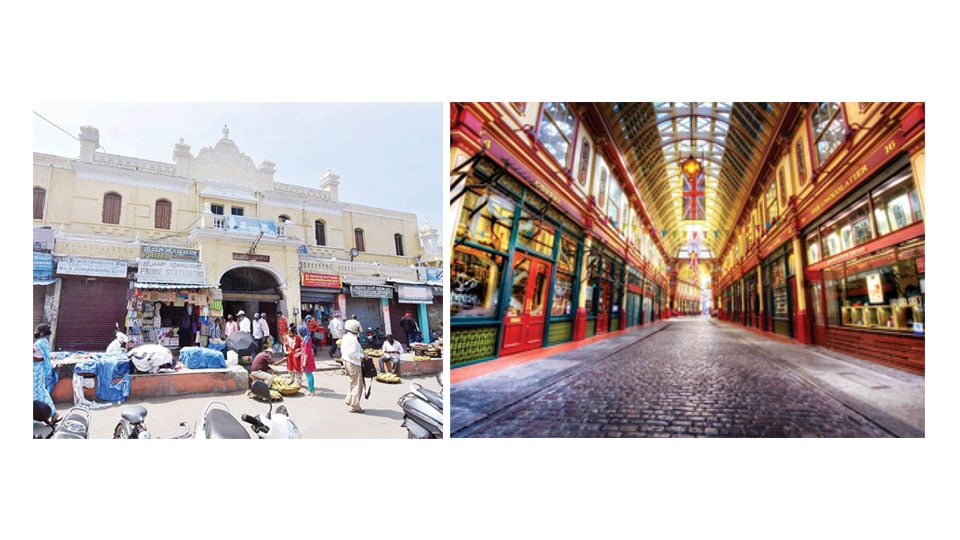Sir,
The images above are of the Leadenhall Market situated in the Central district of London. This structure was built in 14th century as a meat market and the original design was very similar to Devaraja Market of Mysuru.
This market is situated in the middle of the financial district with each square foot of real estate costing lakhs of rupees and London itself has overgrown the usage of this market.
However, instead of demolishing such an old structure the authorities of London decided to give it a dramatic redecoration which improved its appearance, enhancing its architectural character by adding ornate roofs and made it a listed heritage building. Today this market hosts butchers, barbers, restaurants & high end brands and also serves as a tourist location.
It is unfortunate that the authorities in Mysuru keep finding random reasons to eagerly demolish heritage structures that have barely crossed the 100-year mark. What’s more appalling is the fact that they find support from a few of the well-travelled citizens of Mysuru.

What Devaraja Market needs is a overhaul of infrastructure & management, restoring it on the lines of Leadenhall Market would not only enhance its beauty but also re-purpose it to be rented by top brands who can fund the maintenance of such buildings.
Countries like Italy & France have shown us how even 1000-year-old buildings can be restored, preserved and made functional for modern day. Mysuru will lose its basic character if it loses the heritage buildings that were part of its original plan.
Hope better sense prevails among the authorities and vested interests advocating demolition of such structures.
_ Manas Ram, a concerned Mysurean, London, 19.6.2022
Note: The correspondent has an argument to win but not a solution to restore the old glory of Devaraja Market like it was done in London’s Leadenhall Market. What is sauce for the English goose cannot be the sauce for the Indian gander. —KBG








In Hindi, we have a saying – kahan Raja bhoj, kahan Gangu tele! Which in short means you cannot compare a King to a oil-extractor!
Dawood Ibrahim’s castles always look better than the homes of their victims! British have to display the looted wealth somewhere!
This person who emailed the above building, calling himself a Mysorean, has no understanding of the issue.
The building in London dating back to 14th Century means it was constructed during the Tudor period, a precious architecture and historically very important, as it dates prior to Shakespeare’s years in London. It was worth saving.
Devaraja Market has very tenuous connection with Nalwadi Wadiyar, it s architecture lies in its front, and is not unique. This market priced itself out as it could not compete with the agile street market s coming up and it was no longer at the centre of a fast expanding Mysore city.
This person who emailed, has no idea of English history, must be an IT techie in London on a work visa.
Hey Raju
You have very ;poor education, being in a third world country and ruled by corrupt politicians. Focus about your politicians and on Modi who begs every foreigh leader he meets to take his IT chies on work visas. There are over 150, 000 illegal indians , who arrived a s students and dropped out and who are hiding in England doing menial work and even then they do not want to return to India./ That says more about your corrupt cesspit called India.
Note when this building was originally constructed. That was when you were ruled by Muslim invaders!
Hey British ke chamche, chappal chaaplus Aka Bisibele baat. Go live in London, in those small petty shop kind of houses which has no space to breathe, Indian cities and Indian homes are much more beautiful, spacious and lively than those British architectures. Know your facts 1st – Modi need not beg anyone.. the world will stop functioning if Indian techies come back to India. You dare to challenge Indians and see what is going to happen to the world. Take this as a warning on your baseless comment.
Let us assume for a moment, that the govt is willing to spend a huge amount for the complete renovation of the Devaraja market building. The people who are currently occupying this building are all vegetable and flower wholesalers/retailers. Will these same people “maintain” the building in prestine condition?? Very doubtful, as they do not have a sense of cleanliness, hygiene and self decipline. Within a few months (not years) the building will be as filthy and dirty as it is today. Further comparing Leadenhall market to Devaraja market is like comparing chalk and cheese!!! Leadenhall Market is occupied mainly by high end retailers and not just by vegetable/flower vendors. The people in UK love to keep their commercial premises neat and clean, to attract high end customers. What is the point in spending huge amounts in restoring the Devaraja market building if the shopkeepers/govt do not maintain the same?? Even after renovation, this building will still be occupied by these same vegetable/flower vendors and not by any high end retailers
Hello @ram
You have a very poor understanding of the issues involved. You have picked the wrong comparison. Any search on this London Market building reveals that it was constructed by a famous architect, and the poster above said, in the Tudor times, centuries ago, and hence is architecturally worth saving. Devaraja market building is not architecturally an important building, not even as important as the Russell Market building in Bangalore, architecturally or historically or what it was marketing. It had stalls whose ownerships were not known, its vegetables and fruits were very expensive and not fresh. hence, customers walked away.
You need to study the history of the country and the city where you work. It appears, you have not like most Indians who arrive and have no sense of the value of the place they adapted, focusing mostly on their earning-I agree most IT techies are like that.
Hello @ram
You have a very poor understanding of the issues involved. You have picked the wrong comparison. Any search on this London Market building reveals that it was constructed by a famous architect, and the poster above said, in the Tudor times, centuries ago, and hence is architecturally worth saving. Devaraja market building is not architecturally an important building, not even as important as the Russell Market building in Bangalore, architecturally or historically or what it was marketing. It had stalls whose ownerships were not known, its vegetables and fruits were very expensive and not fresh. hence, customers walked away.
You need to study the history of the country and the city where you work. It appears, you have not like most Indians who arrive and have no sense of the value of the place they adapted, focusing mostly on their earning-I agree most IT techies are like that.
Correction: You are like most Indians who arrive…
Lansdowne building had shops the size of a match box, not suited to an expanding business, and hence many shop owners left the building to go elsewhere to expand their businesses. Others, simply retired. The shops were boarded up and the building was abandoned.
Devaraja market, had complex ownerships of stalls, was difficult to trace them, besides the high rental costs forced those who were managing the fruit and vegetable shops to price their products high. Customers found street markets to their tastes, where the vendors were from nearby villages, serving much cheaper and freshers produce. Devaraja Market was gradually abandoned .
The comparison with an architecturally exquisite, and historically valuable as being built over 6 centuries ago London Market is spurious.
The above Mysore buildings are not worth saving. What purpose the renovated Lansdowne building would serve? Would the fruit and vegetable vendors in a newly renovated Deavaraja Market pay the more expensive rental costs and still could compete with local markets? The answers are definite NO.
Lansdowne building had shops the size of a match box, not suited to an expanding business, and hence many shop owners left the building to go elsewhere to expand their businesses. Others, simply retired. The shops were boarded up and the building was abandoned.
Devaraja market, had complex ownerships of stalls, was difficult to trace them, besides the high rental costs forced those who were managing the fruit and vegetable shops to price their products high. Customers found street markets to their tastes, where the vendors were from nearby villages, serving much cheaper and freshers produce. Devaraja Market was gradually abandoned .
The comparison with an architecturally exquisite, and historically valuable as being built over 6 centuries ago London Market is spurious.
The above Mysore buildings are not worth saving. What purpose the renovated Lansdowne building would serve? Would the fruit and vegetable vendors in a newly renovated Deavaraja Market pay the more expensive rental costs and still could compete with local markets? The answers are definite NO.